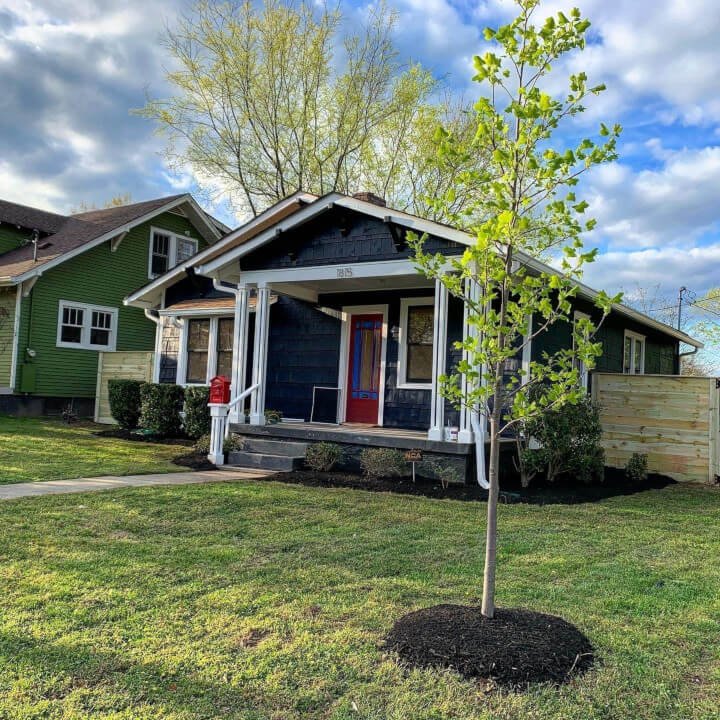What Are the Best Trees to Plant Near Your House?
The Right Tree in the Right Place
Planting a tree may require more forethought than you think! There are lots of things to take into consideration when choosing the location for a sapling, including its purpose, maintenance needs, your yard’s soil type, and in particular, the mature size of the tree. Big trees shouldn’t be planted too close since they can become hazards to people and property if they grow to full size in the wrong spot, while small trees can be planted closer to a house with fewer issues.
The Size of a Tree
When landscaping, it’s important to take the longer term into account and remember that a sapling won’t stay that size for its whole life. Oaks and maples can grow very big relatively quickly, taking on one or two feet per year, while sycamores and elms can take on three or four feet in the same amount of time! Although it’s desirable to get these shade trees established quickly to benefit from their effects, these trees grow up to and beyond 50 feet tall, which may cause some problems years later.
These big, wide, and bushy trees are wonderful additions to a yard, but they need a lot of space to grow. When a big tree is planted too close to a house, its branches may hang over the roof, and if they become weak, they may break and cause damage to the house or a person nearby. A particularly weak tree or a strong storm might cause the whole specimen to fall, endangering proximate people and property.
Less dangerously (but just as disruptive), a tree may damage older water lines, waterlines not installed correctly, or your house’s foundation if planted too close to the building or its infrastructure. A tree’s roots grow out as far as its branches reach, but since they aren’t visible underground, this extension isn’t very obvious until a problem occurs. The best rule of thumb when planting a tree is to keep it as far from a building as its expected mature height so it will have enough room to grow into a healthy, mature tree with minimal hazards and maximum benefits.
What Trees Should You Plant Close to a House?
When considering the layout of your yard, think of your home as the center of the planting radius, with smaller bushes and understory trees being better to plant close to the structure and the tallest trees the furthest from the house (and from any infrastructure, like water lines or power lines). Good trees to plant near a house are ones that won’t get very big or heavy or fall over onto a building.
When choosing small trees to plant near a house, their purpose will be the next most important factor in deciding which species to choose and exactly where to plant it. The purpose of a tree may be:
Shade – Big, bushy trees with large crowns are shady powerhouses, but small trees that are planted in the right place can also be effective at shading a window. Trees like the white dogwood, dwarf crabapple, black gum, and eastern and merlot redbud all grow dense foliage that will block the heat and brightness of the spring and summer sun.
Privacy – Shade trees can also add a level of privacy, but since many of them lose their leaves during the fall and winter, other species may be chosen to do the job year-round. The Taylor eastern red cedar and Brodie red cedar grow in tall and in tight form, while the regular eastern red cedar, holly, and Little Gem southern magnolia offer bushy screening options.
Ornament – If you’re looking for a little something extra in your garden, there are many small trees that have flowers or unique shapes or colors to them that will add another layer of interest to the landscape. Good candidates include the Sweetbay magnolia, crepe myrtle, Japanese maple, Japanese cherry tree, and Allegheny serviceberry.
Habitat – Any native tree is a good choice to provide habitat for local wildlife! Small and dwarf trees still provide important cover for birds, insects, and small mammals throughout the year.
Even though small trees and bushes can be planted closer to a house, be sure not to plant them right against the building. Tall, bushy trees that are too close might cause moisture buildup on exterior walls, and the shade they create may attract insects or mold. Similarly, fruiting trees should be given some room since their fruit will drop and, if not picked up right away, will attract wildlife, while untouched fruit will rot when left for too long. Whether close to the house or in the back of the yard, be sure to have trees pruned and trimmed regularly to keep them healthy!
If in doubt, check with your tree salesperson to be sure how tall a tree will grow and how close or far it may be planted from your house without carrying the potential for damage to the building. Consider purchasing your next tree(s) through the Nashville Tree Conservation Corps’ annual tree sale, open October through February!
Sign up for our newsletter for regular tips on tree care, and if you’d like to lend a helping hand to support trees around town, learn more about volunteering with us.

